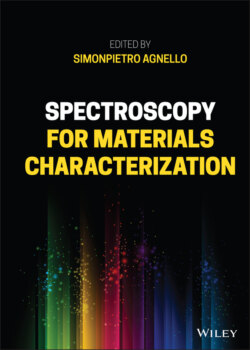Читать книгу Spectroscopy for Materials Characterization - Группа авторов - Страница 53
3.2.1.1 Dispersion Effect: Group Velocity Dispersion
ОглавлениеWhen dealing with optical pulses with femtosecond pulse durations, it is important to consider the effects of group velocity dispersion (GVD). The latter affects the duration of a light pulse which traverses any media, because of the frequency dependence of the refractive index n(ω). GVD is defined as:
(3.1)
where v g is the group velocity. The latter can be written as:
(3.2)
GVD is measured in fs2 mm−1 and, in a transparent region, is typically positive because of the characteristic dependence of n on frequency. During propagation, every spectral component of the pulse acquires a different delay, resulting in a temporal broadening of the pulse without any spectral changes [21]. To visualize the effect of GVD on a Gaussian pulse passing through a medium, a simulation is shown in Figure 3.1. From top to bottom, three pulses are shown, representing a transform‐limited Gaussian with FWHM = 5 fs centered at 550 nm, and the same pulse after passing through 1 or 2 mm SiO2, respectively. As evident from the figure, GVD substantially enlarges the pulse duration, increasing it to several hundreds of femtoseconds. The pulse duration Δt, that is the FWHM of the Gaussian intensity profile, broadens to Δt b given by:
(3.3)
where L is the propagation length inside the material [19]. Besides broadening, GVD causes a frequency chirp, that is a time dependence of the instantaneous frequency of the pulse, given by . In Figure 3.1, the chirp is evident from the comparison of the frequencies of the two sides of the pulse, showing that the instantaneous frequency is redder in the front part of the pulse and bluer in the back [19, 20], which is exactly the effect of a positive GVD. In particular, the instantaneous frequency acquires an approximately linear time dependence, ω(t) = ω 0 + αt, because the phase of the wave acquires a quadratic time term.
Figure 3.1 Panel (a): Simulation of a gaussian pulse centered at 550 nm with FHWM = 5 fs (first curve from the top) after propagation through a SiO2 medium of 1 mm thickness (second curve) and 2 mm (third curve). Panel (b and c): zooms of the tails of the black pulse (squares). Each wavelength is delayed by a different phase, resulting in a longer pulse with a positive chirp (the redder frequencies are faster than the bluer).
Pulse broadening and chirp acquired by femtosecond pulses during their propagation in optical setups need to be put under control in order to preserve good time resolution. One way to do it is to limit the use of transparent optical components, preferring the use of reflective optics only. Some special methods exist to manipulate the chirp, such as what is called a pulse compressor, built by using a pair of prisms or gratings. In a pulse compressor, one can add negative GVD (redder part of a pulse propagates slower than the blue part) which compensates the effect of pulse broadening in a transparent media, recompressing the pulse [19, 20].
Last but not least, dispersion also affects the temporal overlap of two pulses centered at different wavelengths which pass through the same medium, because their group velocities are generally different: this effect is called group velocity mismatch, or GVM. Thereby, if the pulses are initially overlapping in time at a certain point in space, they overlap no more after some propagation distance within a dispersive medium. The GVM effect, for example, can be very important in the generation of pulses through nonlinear effects because it can limit the effective interaction length between the two pulses.
